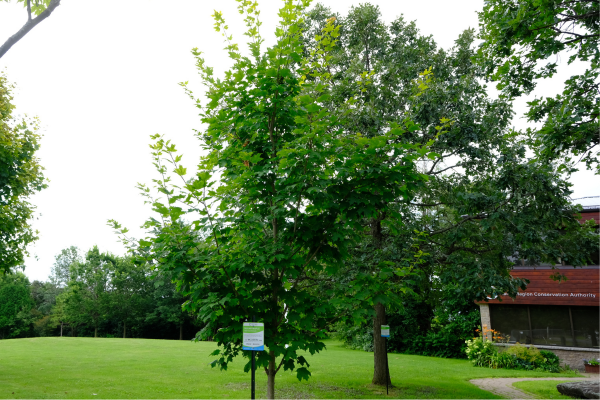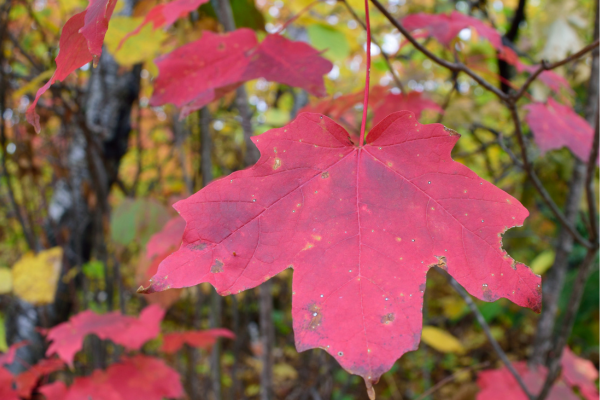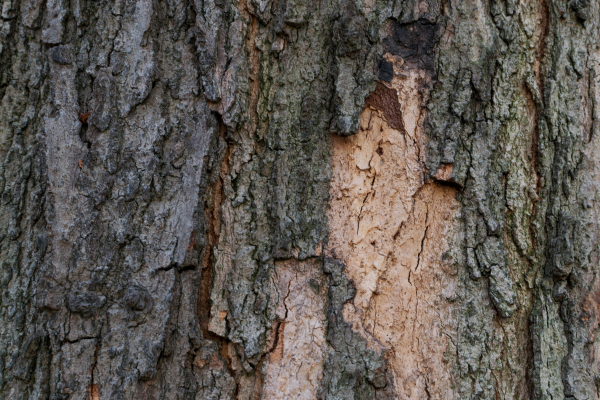Scientific name: Acer saccharum
Acer = Derived from the Latin word meaning “sharp” or “hard” which could refer to the hardness of its wood.
saccharum = Derived from the Greek word sakkharon meaning sugar, referring to the sugary syrup produced by the tree.
The sugar maple is Canada’s national tree, with its leaf serving as the primary emblem on our flag! These trees are found throughout central and southern Ontario and are a dominant canopy species throughout northeastern hardwood forests of North America. Sugar maples are commonly browsed by deer, hares, porcupines, and moose. Squirrels and chipmunks also feed on their seeds, buds, and twigs. The branches and canopy of Sugar Maple provide shelter for birds and insects.
Sugar Maples grow best in soil that is moist, deep, rich, and well drained. While they do tolerate shade, full sun is ideal. Their roots spread deep and wide, and they develop a dense crown, making them an ideal choice for a shade tree in landscaping. Sugar maples can grow to be 35 meters tall and live for over 200 years.
The wood from Sugar maples can be used for a variety of products. This includes furniture, cabinetry, flooring, cutting boards, interior finishes, bowling lanes, veneer, musical instruments, and sporting equipment. Sugar maples are most known for the sap they produce. This sap has the highest sugar content of any other maple species at 3-6%. However, it still takes a lot of sap to produce maple syrup, with 30 to 40 liters of sap only making 1 liter of syrup! To see the full process behind making maple syrup, check out "Making Maple Syrup at Home (Start to Finish)." If you want to learn how to make maple taffy, see "How to Make Maple Taffy / Maple Candy." Be sure to have adult supervision when working with hot maple syrup.
Sources:
OMNR, 2022. Ontario Ministry of Natural Resources: Ontario Tree Atlas. [online] Available: https://arboretum.uoguelph.ca/thingstosee/trees/sugarmaple
OMNR. Ontario's Tree Atlas. [online] Available: https://pecmastergardeners.ca/wp-content/uploads/2020/07/Ontarios-Tree-Atlas.pdf
University of Guelph. Guelph Arboretum: Sugar Maple - Acer saccharum. [online] Available: https://arboretum.uoguelph.ca/thingstosee/trees/sugarmaple
%20938-3611%20info%40rrca_on_ca%20rrca_on_catrees%20(400%20%C3%97%20200%20px)%20(1).jpg)


 This sugar maple is very special as it is the 1 millionth tree planted by the RRCA.
This sugar maple is very special as it is the 1 millionth tree planted by the RRCA. Leaves are 7.5 to 13 cm in length and width with five lobes that are long, pointed and have long pointed teeth at varying lengths.
Leaves are 7.5 to 13 cm in length and width with five lobes that are long, pointed and have long pointed teeth at varying lengths.  The bark becomes dark and ridged as the tree ages.
The bark becomes dark and ridged as the tree ages.  It is better to prune sugar maple in August when the sap flow is slower. If pruned in early spring like most trees, it will lose a lot of sap which is not great for maple syrup production.
It is better to prune sugar maple in August when the sap flow is slower. If pruned in early spring like most trees, it will lose a lot of sap which is not great for maple syrup production.